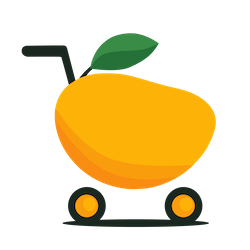Most marketing advice isn’t designed for solo entrepreneurs like you.
It’s written for big companies with big teams and even bigger budgets.
When someone is already interested in what you’re selling (that’s what “low funnel” means), you don’t need complicated systems to get them to buy. You need straightforward approaches that actually work when you’re doing everything yourself.
As a course creator, coach, or digital product seller, you’re probably tired of advice that assumes you have a marketing department.
I get it. That’s why this guide takes a different approach.
–
The L.O.W.E.R. Framework™: A Simple System for Solo Digital Entrepreneurs
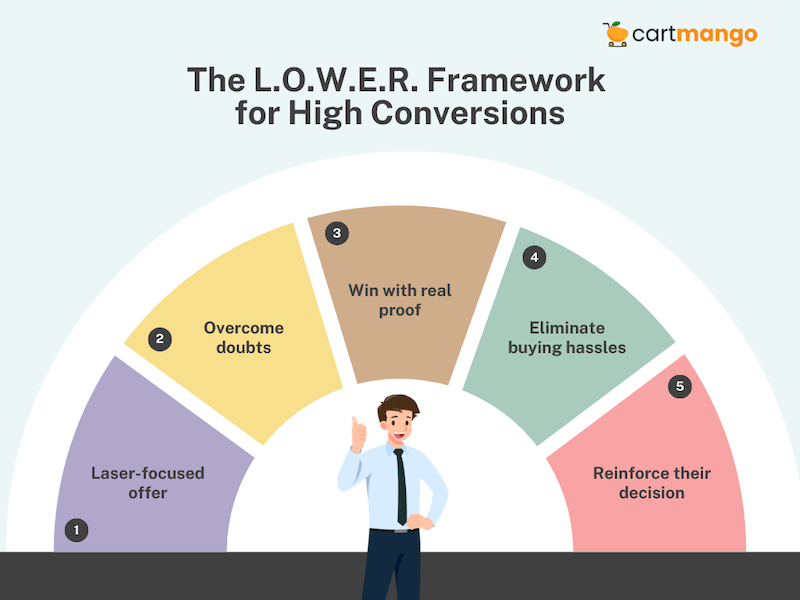
After observing patterns among successful solo entrepreneurs, I’ve noticed they often don’t follow conventional marketing wisdom. Instead, they seem to follow a pattern I’m calling the L.O.W.E.R. Framework:
- Laser-focus your offer (make it crystal clear exactly what they’re getting)
- Overcome doubts (address the specific concerns holding people back)
- Win with real proof (show evidence that works better than promises)
- Eliminate buying hassles (make purchasing quick and painless)
- Reinforce their decision (make them feel great after buying)
According to Baymard Institute, 74% of customers are more likely to buy when checkout is fast and easy. Let’s break down each step of this framework in practical terms.
–
Step 1: Laser-Focus Your Offer – Clarity Beats Complexity
Here’s something most marketing experts won’t tell you.
When someone is close to buying, adding more features and benefits often pushes them away instead of pulling them in. A cluttered offer confuses people.
And confused people don’t buy.
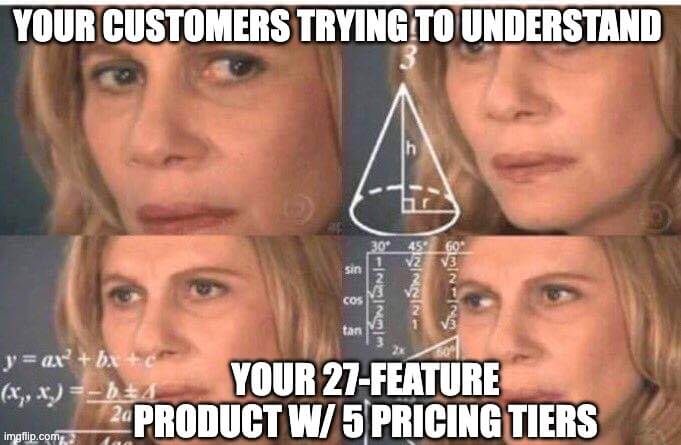
What to do instead:
Use the “What Do They Really Want?” exercise.
Look at your last 5-10 sales calls or customer emails. What specific result were they most excited about? That’s your focus.
For almost-ready buyers, your messaging needs to be crystal clear about exactly what they’ll get. Not everything your product could potentially do someday.
Element | For New Visitors | For Almost-Ready Buyers |
|---|---|---|
Main Headline | Focus on the problem you solve | Focus on specific results and how quickly they’ll get them |
Features to Mention | Show everything your product does | Only highlight the 2-3 features that directly address their main concern |
Proof to Show | Numbers (like “1000+ customers”) | Specific examples of people like them who got results |
Button Text | “Learn More” or “See Details” | Clear next step like “Start Your Course” or “Get Instant Access” |
Consider this hypothetical scenario:
A course creator might start with a comprehensive list of all 47 lessons in their program. But after simplifying to focus on the three most valuable outcomes, they might see better conversion rates.
Why? Because when someone is close to buying, they don’t need more information. They need the right information that addresses their specific concerns.
–
Step 2: Overcome Doubts – Address Concerns Before They Stop the Sale
Now that you’ve clarified your offer, it’s time to tackle the specific concerns that prevent folks from moving forward.
Most marketing experts tell you to maximize leads. Get as many potential customers as possible.
But for solo entrepreneurs, this approach burns you out and waters down your messaging. You can’t be everything to everyone.
According ConversionXL, when something costs more money or is more complicated, folks need more time to think about it before buying. It’s like how you might quickly grab a candy bar at checkout, but you’d spend weeks researching before buying a car or house.
The “What’s Stopping Them?” method:
When someone doesn’t buy after showing interest, reach out with a simple question: “Just curious – what held you back from moving forward?”
Keep track of these responses.
After 5-10 answers, patterns emerge. Those patterns are gold. They tell you exactly what’s preventing sales.
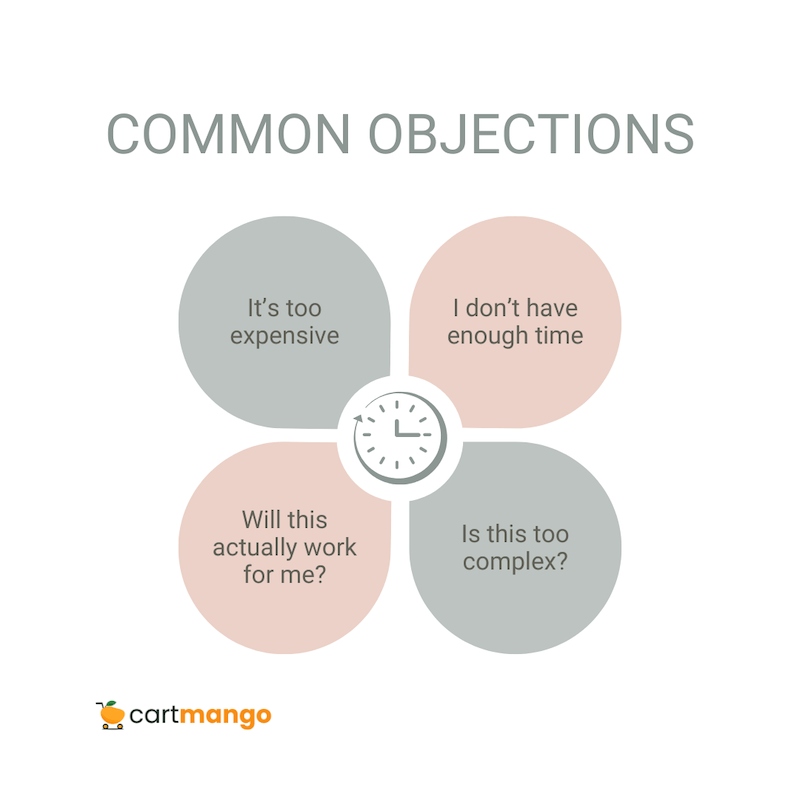
What They’re Worried About | What Doesn’t Work | What Actually Works | Real-Life Example |
|---|---|---|---|
“It’s too expensive” | Just offering a discount | Showing the specific value they’ll get compared to the price | A clear ROI calculation showing potential returns |
“I don’t have enough time” | Saying “it only takes 10 minutes a day” | Being honest about the time needed and showing why it’s worth it | A realistic time commitment with a flexible implementation schedule |
“Will this actually work for me?” | General guarantees or promises | Specific examples of people like them who succeeded | Customer stories that match their situation |
“Is this too complicated?” | Saying “anyone can do it” | Showing exactly how you’ll help them succeed step by step | A sample of your step-by-step instructions or support |
When you directly address the exact concerns your potential customers have, they feel understood. You’re not just another person trying to sell them something. You “get” them.
–
Step 3: Win with Real Proof – Evidence Beats Promises
Once you’ve identified objections, you need compelling evidence to overcome them. This is where another contrarian principle comes into play.
Most marketing tells you to make everything look polished and professional. But for solo entrepreneurs selling courses and digital products, too much polish can actually hurt your credibility.
Authentic testimonials that address specific concerns outperform general praise. Their research shows that overly polished testimonials often trigger skepticism, while authentic, detailed accounts build trust.
The key difference between this step and the previous one is that now we’re focusing on providing actual evidence, not just identifying concerns.
Type of Proof | When Someone’s Just Learning About You | When Someone’s Almost Ready to Buy | Where to Put It |
|---|---|---|---|
General numbers and stats | Works well | Not very convincing at this stage | Your homepage |
Specific customer results | Somewhat effective | Very effective | Your sales page |
Behind-the-scenes videos | Not very effective | Surprisingly effective | Pre-purchase emails |
Stories addressing specific concerns | Somewhat effective | Very effective | Near your buy button |
Getting powerful testimonials (even with few customers):
Instead of asking “Would you write a testimonial?”, try this approach: “Would you be willing to answer 3 quick questions about your experience?” Then ask:
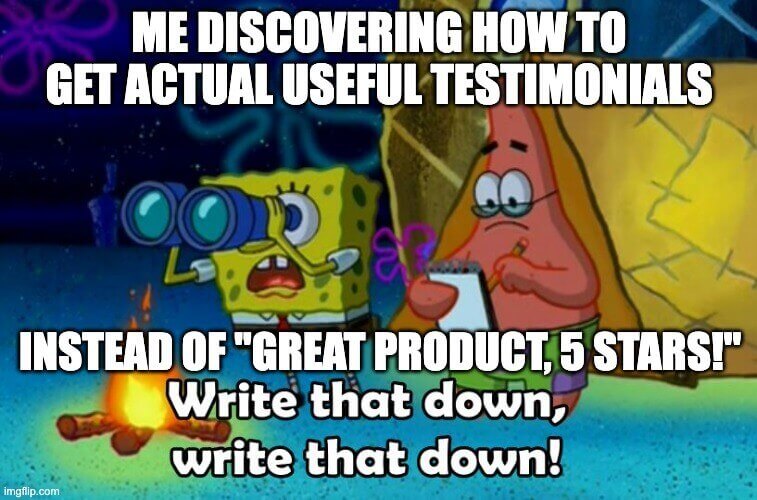
- What was your situation before using the product?
- What specific result did you get?
- What would you tell someone who’s considering buying but isn’t sure?
These questions naturally create before/after stories that address common concerns. Much more effective than generic praise.
Remember, what makes proof work at this stage isn’t how professional it looks. It’s how relevant it is to the exact concerns your almost-buyer has right now.
–
Step 4: Eliminate Buying Hassles – Make Purchasing Simple
With a clear offer and compelling proof in place, it’s time to address another critical aspect of converting almost-ready buyers: removing friction from the purchase process.
This is where most marketing advice gets it completely backward for solo entrepreneurs. The big marketing platforms want you to add upsells, cross-sells, and complicated checkout flows.
For most solo digital entrepreneurs, simpler checkout processes result in more sales.
Use the Friction Finder exercise to spot problems:
Where to Look | Common Problems for Solo Creators | Simple Fixes |
|---|---|---|
Your Sales Page | Too many pricing tiers confusing buyers | Offer just 1-2 clear options (the most popular and premium) |
Unclear what happens after purchase | Explicitly state the next steps after buying | |
Hard-to-find buy buttons | Use large, contrasting buttons with action-oriented text | |
Your Checkout | Asking for unnecessary information | Only collect email and payment details |
Forcing account creation | Enable guest checkout for first-time buyers | |
Surprise fees or taxes at final step | Show the total cost upfront, including any processing fees | |
Mobile Experience | Tiny buttons that cause mis-taps | Make all clickable elements at least 44px high |
Forms that are tedious on phones | Use single-page checkout when possible | |
Text too small to read details | Use minimum 16px font size for important information | |
Post-Purchase | Unclear how to access the product | Provide immediate access information on the confirmation page |
No immediate confirmation | Set up automatic welcome emails with access details |
About 60-65% of online shopping happens on mobile devices according to Statista. So your checkout absolutely must work well on phones.
Many solo creators find that specialized checkout tools designed for digital products (like CartMango) perform better than general e-commerce/cart/checkout platforms. These tools are built specifically for selling digital products and offer streamlined setup processes for digital businesses.
A simple checkout process typically increases conversion rates by removing unnecessary steps between the decision to buy and completing the purchase. Fewer steps mean fewer opportunities for potential customers to change their mind or get distracted.
–
Step 5: Reinforce Their Decision – Don’t Stop at the Sale
After simplifying the purchasing process, your work isn’t done.
In fact, a critical part of low funnel marketing happens after the purchase is complete.
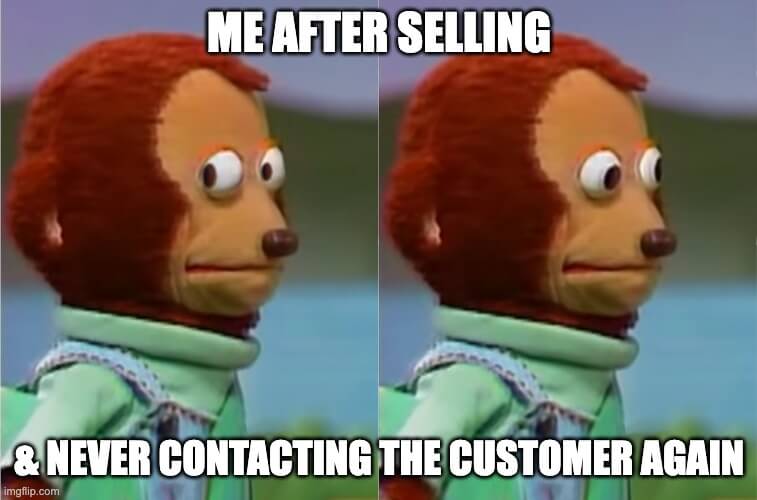
Here’s where most marketing advice completely misses the mark. The “bottom of the funnel” doesn’t end when someone buys.
What happens immediately after purchase dramatically affects customer satisfaction, refund rates, and future sales.
According to research published in the Harvard Business Review, reducing customer effort is a better predictor of loyalty than “delighting” customers. In other words, make it easy to get started with your product.
The “First Win Fast” approach:
The faster a customer achieves something with your product, the more likely they’ll stick with it. Design your onboarding to give them a quick success in the first 24-48 hours.
For a course creator, this might mean a 5-minute “quick start” video that gives them an immediate small win. For a digital product, it could be a template they can use right away.
Many new customers feel uncertain after purchasing. It’s normal. They just spent money and now they’re wondering if they made the right choice.
A simple email sequence addressing common questions and highlighting quick wins can help reinforce their decision and potentially reduce refund requests. This sequence doesn’t need to be complex – just 2-3 messages that guide them to that first success.
How to Apply This to Your Specific Business
Now that we’ve covered the entire framework, let’s look at how to adapt it to your particular type of business. Different types of digital entrepreneurs need to apply these principles in slightly different ways.
Framework Step | For Course Creators | For Digital Product Sellers | For Coaches and Consultants |
|---|---|---|---|
Laser-Focus | Highlight one specific transformation instead of all course contents | Show one clear use case instead of all features | Focus on one specific problem you solve best |
Overcome Doubts | Address concerns about course completion | Emphasize ease of use and instant access | Show how your approach differs from free advice |
Win with Proof | Share before/after results from actual students | Show real customer projects created with your product | Include specific client transformation stories |
Eliminate Hassles | Simplify enrollment with one-click access | Use a streamlined checkout process | Make booking a session straightforward |
Reinforce Decision | Send an immediate welcome video | Provide quick-start templates | Send pre-session preparation materials |
For course creators, showing a preview lesson that delivers immediate value can give potential customers a taste of your teaching style.
For digital product sellers, demonstration videos showing the product in use by someone similar to your target audience can be particularly effective. These videos help customers visualize themselves using and benefiting from your product.
For coaches and consultants, specificity in your messaging matters greatly. Those who position themselves as specialists in solving specific problems tend to convert better than generalists.
–
The Bigger Picture: How The L.O.W.E.R. Framework Fits into The Complete Marketing Funnel Strategy
Now that you’ve learned about the L.O.W.E.R. Framework and how to apply it to your specific business, let’s zoom out and see how this approach fits into the broader landscape of marketing.
The marketing funnel describes the journey people take from first hearing about you to becoming paying customers. Think of it like a coffee filter. At the top, you pour in lots of water (potential customers), but only a portion makes it through to your cup (actual buyers).
Most businesses divide their marketing efforts into three main areas:
Funnel Stage | Real-World Example | What’s Happening |
|---|---|---|
Top of funnel (upper funnel) | Someone realizes their website isn’t generating leads | They start searching for general information about online marketing |
Middle of funnel | They learn about different approaches and start comparing options | They’re weighing different solutions but aren’t ready to buy |
Bottom of funnel (lower funnel stage) | They’ve narrowed down to a few specific options | They’re deciding which specific solution to purchase |
The L.O.W.E.R. Framework we’ve been discussing focuses specifically on the bottom of funnel – people who are almost ready to buy but need that final push.
Watch this short video:
Why Lower Funnel Marketing Deserves Special Attention
When someone enters the bottom of funnel, they’ve already:
- Recognized they have a problem worth solving
- Decided to invest time or money in a solution
- Narrowed down their options (with your offering among them)
These prospective customers are much closer to making a purchase decision than someone just beginning their buying journey. They need different information and experiences to move forward.
While top of funnel marketing might build brand awareness, focusing on lower funnel marketing strategies typically delivers faster results for solo entrepreneurs. These are people who already know about you – they just need the right nudge to become paying customers.
According to conversion specialists, focusing on almost-ready buyers is substantially more cost-effective than trying to convert cold traffic, simply because they’re already interested in what you offer.
How Other Marketing Activities Support Your Lower Funnel Efforts
The 7-day plan we’re about to discuss focuses on lower funnel marketing tactics, but it’s worth understanding how other marketing campaigns support this work.
Your upper funnel activities – like blog posts, videos, or podcast appearances – create awareness and begin relationships. Without some form of top of funnel marketing, you’ll eventually run out of people to convert.
Your digital marketing activities work together across the entire customer journey:
- Helpful content builds awareness (creating content for the awareness stage)
- Email newsletters and social media nurture interest (to nurture prospects)
- The L.O.W.E.R. Framework converts interested prospects (converting potential customers)
- Post-purchase support increases repeat business (extending customer lifetime)
As a solo entrepreneur, you need a customized strategy that addresses all stages, but with appropriate focus on each based on your specific situation and resources.
Some marketing tactics that complement the L.O.W.E.R. Framework include:
- Email marketing sequences that gradually warm up prospects
- Social media ads targeting people with interests related to your solutions
- Retargeting campaigns that reconnect with people who’ve previously visited your site
- Landing pages focused on specific problems your solution addresses
The value of having this solid understanding of the entire funnel is that you can make strategic decisions about where to focus your limited resources. For most solo entrepreneurs, balancing some basic awareness activities with strong lower funnel efforts delivers the best results.
Now, with this broader context in mind, let’s look at how you can implement the L.O.W.E.R. Framework with our practical 7-day plan.
–
The 7-Day Plan to Improve Your Conversions
With the framework and business-specific applications in mind, let’s create an action plan to implement these ideas.
Here’s what you can do this week to start improving your conversions:
Day | Simple Task | How Long It Takes | What You’ll Have When Done |
|---|---|---|---|
1 | Find where people get stuck before buying | 60-90 minutes | A list of the main reasons people don’t buy |
2 | Simplify your offer description | 90-120 minutes | A clearer explanation of what you’re selling |
3 | List the top 3-5 concerns people have | 60 minutes | Specific doubts you need to address |
4 | Create 2-3 pieces of specific proof | 2-3 hours | Testimonials or examples that address main concerns |
5 | Simplify your checkout process | 60 minutes | A faster, easier way for people to buy |
6 | Create your post-purchase messages | 2-3 hours | Emails that make new customers feel good about buying |
7 | Set up simple tracking | 60 minutes | A way to see if your changes are working |
This plan focuses on the highest-impact improvements you can make in just one week. No special technical skills required. Just straightforward changes that make sense for solo entrepreneurs.
I’d suggest starting with Day 1 immediately.
Most people want to jump straight to creating proof or fixing their checkout. But if you don’t know what’s actually stopping people from buying, you’re just guessing.
–
Common Questions About Converting Almost-Ready Buyers
As you implement this framework, you might have some questions about the process. Here are answers to some of the most common ones:
How can I tell if someone is actually close to buying or just browsing?
Look for behavioral signals: They’ve visited your sales page multiple times, opened several emails, or viewed your pricing page. These are strong indicators they’re considering a purchase.
Do I need different approaches for people coming from social media versus my email list?
Generally, email subscribers are further along in the buying process. They’ve already shown enough interest to give you their email. Social media visitors usually need more warming up before they’re ready to buy.
When should I try to fix what I’m doing versus starting over with a different approach?
If you’re getting consistent traffic but few sales, focus on fixing your conversion process. If you’re getting no traffic at all, then your offer or audience targeting needs rethinking. The benchmark to aim for varies by industry, but typically conversion rates for digital products range from 1-5% according to conversion optimization experts.
What numbers should I actually pay attention to in my business?
For most solo entrepreneurs, these are the only metrics that matter initially:
- Conversion rate (what percentage of visitors buy)
- Average order value
- Refund rate
Get these right before worrying about anything else.
–
What Next?
The big secret here? Your small size is actually an advantage in low funnel marketing. You can be nimble, authentic, and personal in ways big companies can’t.
Personal connection impacts purchasing decisions.
As a solo entrepreneur, you can create genuine connections with your audience. You can respond quickly to their concerns. You can show your human side.
While big companies are stuck in meetings discussing their marketing automation strategy, you’re having real conversations with real people.
That’s powerful.
By implementing the L.O.W.E.R. Framework, you’re not just making isolated improvements to your marketing. You’re creating a cohesive system designed specifically for converting almost-ready buyers without complex systems.
Start with one step today. I’d recommend beginning with the Laser-Focus section.
Simplify your offer and make it crystal clear exactly what transformation you provide.
Then move through the rest of the framework at your own pace. Even implementing just one section will likely improve your results. Implement all five, and you’ll have a conversion system that outperforms most of your competitors.
Successful marketing for solo entrepreneurs isn’t about doing more. It’s about doing the right things.
And now you know exactly what those right things are.
Related
- Podia vs Gumroad: The Recurring Revenue Handcuffs (2026)
- SendOwl vs Gumroad: The Recurring Revenue Black Hole (2026)
- Gumroad vs Sellfy: The Vendor Lock-in Cage (2025)
- Gumroad vs Payhip: The Hidden Trap for Creators (2025)
- ThriveCart vs SamCart – The Subscription Hostage Trap (2025)
- 8 ThriveCart Alternatives & The Lifetime Pricing Paradox (2025)
- 8 SamCart alternatives + Subscription hostage (2025)
- The GENTLE Method: Soft marketing for creators
- How Far in Advance Should You Promote a Webinar?
- The SAVINGS Method: The Productivity Improvement Plan for Creators
